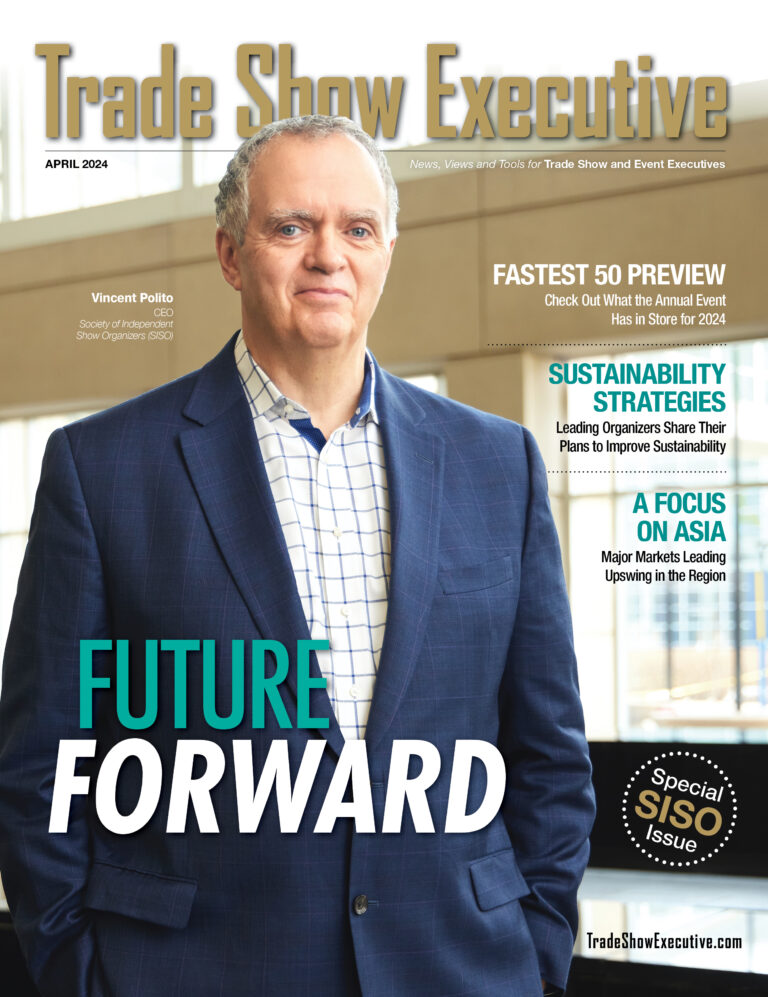Munich, Germany – Small businesses are seen as an untapped pool of customers for European trade shows, and organizers can take steps to accommodate the needs of large companies and international exhibitors, industry experts said at a recent seminar presented by UFI – The Global Association of the Exhibition Industry.
The European practice of allowing individual exhibitors to carry out the move-in and move-out of their own booths is undoubtedly an attraction to cost-conscious small and medium enterprises (SMEs). It also increases the traffic headaches of the show managers who are responsible for having everyone and everything in place when the curtain goes up.
“Time is money,” said Karl Mayer, vice president of the German logistics company Kuehne + Nagel. “And this demand is becoming more serious. The time frames for setting up and dismantling an exhibition are being reduced, and very often the show coincides with a weekend.”
Mayer told an audience of more than 50 members of UFI that a firm hand was needed to manage the activities of the many different workers and exhibitors who enjoy a much freer hand than they do in the U.S.
“As service providers and organizers in the exhibition industry,” Mayer said, “we have to accept the challenges in a cooperative partnership and have to initiate changes, even if they may seem partly unfamiliar and strange to some of us.”
Economy Adds to Time Pressures
According to a survey released at the session, it takes from 3.1 to 4.7 days to set up a mid-sized trade show in Europe, depending on the number of custom-built booths involved. Dismantling requires an average of 1.7 to 2.3 days.
The survey, which included input from 40 UFI members in 26 countries who were show organizers, venue managers and service providers, also found that less than half had service level agreements with their freight forwarders (47%) or assigned their service providers to specific exhibition halls (44%).
On top of that, a growing number of venues are often juggling multiple shows taking place at the same time, which adds to the logistical bustle. Exhibitors are also increasingly anxious to cut the amount of time it takes to set up their booths. “As the recession worsens, all budgets for participation in trade shows are scrutinized and shortened,” Mayer said. “Fixed costs remain extremely high, particularly personnel costs for the service providers as well as the provision of technical equipment.”
Do-it-Yourself Headaches
Matthew Williams, logistics operations director at Britain’s Melville Exhibition & Event Services Ltd., told Trade Show Executive that logistics at European events operated in a much looser environment than tightly controlled U.S. shows. “Logistics within Europe are a free market,” he said. “Very little is unionized. Although we may be appointed for a show, exhibitors and contractors can show up in tail-lift vehicles and unload themselves.”
Since the exhibit floors of most European convention centers are on ground level, vehicles can simply pull up and unload or drive into the building itself. Once unloaded, the idea is that drivers promptly get their vehicle off to a parking lot. “If you have a show that requires the use of heavy lifting equipment, then the logistics contractor will generally add their own traffic-control people to the car parks in order to get the right vehicles to the loading docks,” Williams said.
Try as they might, however, show managers can find themselves stuck in situations in which inexperienced exhibitors are blocking the unloading areas, and the sheer number of vehicles has ground traffic to a halt.
Mayer said such gridlock has forced his staff to stop work for several hours while the mess is sorted out. “The smaller and medium-sized shows are much more affected by this than the leading trade fairs,” he said.
The Rise of SMEs
Managing the ebb and flow of small-truck exhibitor traffic shows every sign of becoming a more daunting challenge for show managers in the coming years as small businesses are actively courted.
Berislav Cizmek, CEO of CBBS – Management Consulting & Business Building Company, said at UFI European Day this Spring that SMEs represented a promising pool of new customers for the trade show industry. He cited statistics estimating the number of SMEs in the 27-nation European Union at approximately 25 million. Of that number, 90% were not active trade show exhibitors and between two million and five million were considered to be potential exhibitors.
Batibouw Setting the Trend?
Shows that require heavy lifting, such as events linked to construction or Europe’s auto industry, tend to attract major exhibitors rather than SMEs. But UFI speakers pointed to major shows such as Batibouw, Europe’s largest construction show, as an example of traffic management that could translate to smaller events fortunate enough to experience a boom in SME exhibitors.
Geert Maes, general manager of Fisa SA in Brussels, said that with 120,000 square metres (1.3 million square feet) of exhibit space spread around 13 separate exhibition halls, the idea of exhibitors showing up at their leisure was no longer an option.
Instead, exhibitors are assigned specific days that they will have access to the exhibit hall during the designated move-in period. There is also an optional “pre-build” period during which exhibitors can pay an extra fee for extra time to set up their exhibits before the official move-in begins. Drivers are also required to pay a deposit at the door guaranteeing they will not stay longer than the time allotted for unloading. If they return to the cash desk too late, they forgo a payment of as much as €100 (roughly $138). The dismantling period is handled similarly with specific times reserved for large trucks and smaller vehicles. Exhibitors who pay another fee can be first in line to load up their trucks.
Efficiency Pays Off
Tighter traffic control is one of the ideas being discussed among European organizers, venues and service contractors. Others include the pooling of forklifts and other equipment by contractors during move-in, and stricter requirements for deposits and other upfront payments to ensure that exhibitors are paid in full.
Mayer called on the industry to establish a set of best practices that aim to improve the overall effectiveness of trade shows in Europe during a time when changing customer demographics and economic challenges can be daunting.
“Our economic hard times will reveal who really wants to achieve a cooperative relationship rather than simply look for short-term successes,” Mayer said. “For that reason, permanently open communications between the trade fair companies and service providers has to be an absolute priority.”
Reach Karl Mayer at +43 1 90690 1200 or karl.a.meyer@kuehne-nagel.com; Matthew Williams at +44 12 1780 0324 or matthew.williams@melville.co.uk.; Berislav Cizmek at +38 5 1230 4001 or berislav.cizmek@zg.t-com.hr; Geert Maes at +32 2663 1400 or g.maes@batibouw.com











